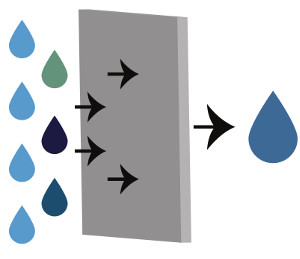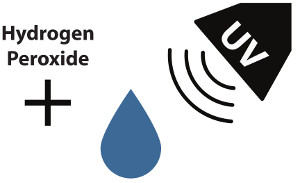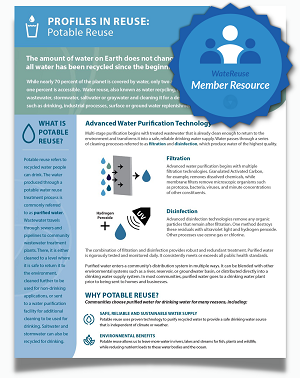Potable Reuse
What is Potable Reuse?
Potable reuse refers to recycled water people can drink. The water produced through a potable water reuse treatment process is commonly referred to as purified water. Wastewater travels through sewers and pipelines to community wastewater treatment plants. There, it is either cleaned to a level where it is safe to return it to the environment, cleaned further to be used for non-drinking applications, or sent to a water purification facility for additional cleaning to be used for drinking. Saltwater and stormwater can also be recycled for drinking.
Advanced Water Purification Technology
Multi-stage purification begins with treated wastewater that is already clean enough to return to the environment and transforms it into a safe, reliable drinking water supply. Water passes through a series of cleaning processes referred to as filtration and disinfection, which produce water of the highest quality.

Filtration
Advanced water purification begins with multiple filtration technologies. Granulated Activated Carbon, for example, removes dissolved chemicals, while membrane filters remove microscopic organisms such as protozoa, bacteria, viruses, and minute concentrations of other constituents.

Disinfection
Advanced disinfection technologies remove any organic particles that remain after filtration. One method destroys these residuals with ultraviolet light and hydrogen peroxide. Other processes use ozone gas or chlorine.
The combination of filtration and disinfection provides robust and redundant treatment. Purified water is rigorously tested and monitored daily. It consistently meets or exceeds all public health standards.
Purified water enters a community’s distribution system in multiple ways. It can be blended with other environmental systems such as a river, reservoir, or groundwater basin, or distributed directly into a drinking water supply system. In most communities, purified water goes to a drinking water plant prior to being sent to homes and businesses.
Why Potable Reuse?
Communities choose purified water for drinking water for many reasons, including:
- SAFE, RELIABLE AND SUSTAINABLE WATER SUPPLY: Potable reuse uses proven technology to purify recycled water to provide a safe drinking water source that is independent of climate or weather.
- ENVIRONMENTAL BENEFITS: Potable reuse allows us to leave more water in rivers, lakes and streams for fish, plants and wildlife, while reducing nutrient loads to these water bodies and the ocean.
Example Potable Reuse Projects
Today’s technology allows us to treat any water to meet freshwater needs including drinking. Many communities have operated potable reuse projects for years. Below are just a few examples:
Upper Occoquan Service Authority (UOSA), Fairfax, VA
In service since 1978, UOSA is the longest operating potable reuse project in the United States. Recycled water is added to the Occoquan Reservoir where it blends with existing surface water. The reservoir supplies water to the Fairfax County Griffith Drinking Water Plant where it is treated to drinking water standards and distributed to approximately 321,000 people. In drought years, up to 80 percent of the total reservoir water pumped to the drinking water treatment plant may be recycled water; in normal years, it is less than 20 percent.
Wichita Falls, TX
Because of severe drought in the 1990s, Wichita Falls constructed an interim potable reuse project that purified wastewater and piped it directly to the Cypress Water Treatment Plant, which cleaned the water again before it was distributed to customers. Since then, Wichita Falls developed a potable reuse system that purifies water and stores it in Lake Arrowhead.
Groundwater Replenishment System (GWRS), Orange County, CA
Orange County’s GWRS has been purifying water since 2008. The GWRS produces 100 million gallons per day (mgd) of purified water, enough to meet the needs of nearly 850,000 customers. The advanced treatment system uses microfiltration, reverse osmosis and ultraviolet light with hydrogen peroxide. The purified water is injected into the local aquifer where it blends with the groundwater.
pureAlta, Altamonte Springs, FL
In 2017, the City of Altamonte Springs launched a potable reuse pilot, pureALTA, to prepare for anticipated water shortages and demonstrate energy-efficient technologies that create a safe and sustainable water supply. The potable reuse pilot treated about 28,000 gallons of water to meet or exceed drinking water standards each day. A full-scale system would treat up to 500,000 gallons of water per day.

